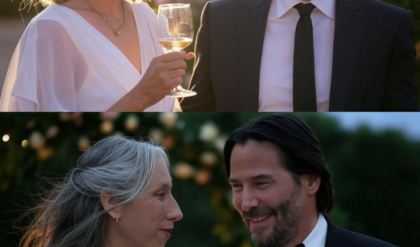It all seems sort of vaguely familiar, but lacks vision and purpose
Now four episodes into its second season, Amazon’s The Lord of the Rings: The Rings of Power continues its baffling mix of attempts at Tolkien-diehard fan-service and utterly uncanonical plot-points. It does a little better at telling a coherent story this time around, but that doesn’t mean its characters have anything like clear motivations, or that it adds up to much more than a generic fantasy story that steals the names of people and places from Tolkien, rearranging them in ways that at first glance seem kind of compelling, but at second, are just dumb.
Take our protagonist, elven-warrior-princess Galadriel. She and her former ally Elrond are much at loggerheads this season, mostly because Galadriel has accepted one of the three rings of power forged by the smith Celebrimbor: Elrond fears that the rings will be subject to corruption by the Dark Lord Sauron, though he had nothing to do with their forging; she sees them as a way for the elves to maintain their power within Middle-Earth. There’s a lot of bickering about it, with Elrond at one point leaping off a waterfall to prevent any of the elves from taking possession of them.
She gets the thing in the end, of course, because if you’ve read the novel or seen Peter Jackson’s movies, you know that’s what happens. What’s also silly about this, if you’ve read the book, is that Elrond ends up with a ring of his own sooner or later. And all of this fret about Sauron’s evil influence misconstrues Tolkien’s mythos regarding them, in which only those touched, in their making, by Sauron, were subject to his influence. It makes the story nothing but random actions, undertaken for reasons that are incomprehensible.
Then, on the other hand, there’s the battle that Galadriel, Elrond, and their morose band of elves have with the barrow-wights on their way to the Celebrimbor’s realm of Eregion, to sort out some of this ring business. They’re traveling through a dark wood, past and over burial-mounds. Spectral figures rise as from out of nowhere, their faces skulls. Battle ensues, but nothing the elves do stops the creatures.
There’s a very clever denouement to the scene, involving the wights’ own weapons. But – here it is again – the barrow-wights don’t even exist, in Tolkien’s canon, until well after Sauron gave the Nine Rings to men, and one of them became the Witch-King of Angmar, a Nazgul wholly under Sauron’s thrawl. The barrow-wights are just thrown in because they show up in The Fellowship of the Ring, and the show-runners are hoping that those of us who love the book will nod along in recognition. The whole scene is nothing but their attempt at extra credit.
One thing I did appreciate about the season so far was its attempt to make something more of the kingdom of men, Numenor, and its politics, than it did last time around. There’s a lot of royal backstabbing going on, with a king lately dead and a queen attempting to have herself crowned regent of the island land. But that sub-plot mostly sputters around, with Isildur, who (we know) ends up cutting the One Ring from Sauron’s hand mostly playing matchmaker to an elven-human romance. Not much of a hero, so far. As far as the throneroom machinations go, it ends up being a lot of interchangeable characters betraying each other for reasons that remain opaque. There’s a nifty scene with a massive eagle making a benefic visit to a court-room, but that’s about as good as it gets.
The Dwarves are better served this season: they are not just buffoons, but actual characters, with real motivations. Durin, banished from the kingdom of Moria by his father for some incomprehensible plot-point of a reason, is eager to enlist the help of (here he comes again) Celebrimbor, who promises to make the Dwarves rings that will make their magical metal, Mithril, do all the magical stuff it used to do so well, but these days doesn’t do so well. It’s not canonical or uncanonical – Tolkien didn’t say that much about the Dwarves, mostly just in passing. Their conflict with each other verges on the stupid, in that we all know they’re going to go ahead and make those rings with Mr. Celebrimbor, and there’s some sappiness to the relationship between Durin and his wife, but at least they come off as real people, this time around.
Now. About those Hobbits. Or Harfoots, or Stoors, as the case may be. And then there’s that Stranger character, the tall, bearded, man-like person, garbed in gray, who’s wandering about with the button-nosed Nori and Poppy, no-nonsense little gals who know how to forage for their dinner and don’t take any gaff from the Big People. When Nori and Poppy and their tall friend come into contact with a tribe of folks who are of similar stature, but who live in holes in the ground instead of tramping about in caravans, they are amazed: folks like them, settled down, rather than wandering? Living in holes? It’s an advance in civilization! But the differences between the wanderers and the settlers get smoothed over, when they have a common enemy to worry about: evil Orcs, looking for the Stranger.
The Hobbits, or whatever the show calls them, don’t amount to much more than a plot point on the way to having the amnesiac Stranger discover who he is, and what the heck he’s doing in Middle Earth. He might stir up a tornado or two, and he might hunker down for a day or two with Tom Bombamdil (somehow uprooted from his house near the Shire to the far easterly land of Rhûn), and he might find power in holding a staff in his hand that he can’t quite control – but look, every recap of this show I’ve read thinks he’s probably the Grey Wizard Gandalf. Maybe he’s not.
But if he is: look, canonically, he has to hang around a while, until Isuldur defeats Sauron, and then go back to Valinor, the land of the gods, and sail back into Middle Earth about 1,000 years later, when good old Celebrimbor hands him a ring to assist him in his fight against Sauron; and then spend another couple of thousand years worriting Sauron over this and that, before smoking pipes with ale-quaffing Hobbits of the Shire. It seems like a lot of wasted time.
And it doesn’t make any sense that this character would be in Middle Earth now. His presence amounts to nothing more than a pandering to the fans of Tolkien who want to see their favorite characters on the TV. It fails, no matter what they end up doing with the character, because we know Gandalf as a wise, almost angelic figure. His arrival, via boat, is well established in the canon. Why is he here a half-wit, finding his way to his power and his mission? This is not The Matrix.
If what you want is a decent-looking fantasy series with some good fight scenes, The Rings of Power will satisfy. Somebody obviously spent some money on the production here. But it doesn’t quite know how to manage political intrigue, though it would love to. If you have read Tolkien, and respect his vision, this is not the show for you. Just watch that old Rankin/Bass adaptation of The Hobbit again, because you won’t find anything more faithful.





